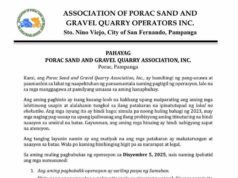NO GOOD! A crisp, if loud, ejaculation I spewed at the 18-minuter Rising from the Ashes screened at the Clark Freeport’s spanking new 4-D Theater inaugurated last Monday.
Truly, NO GOOD. For such high a cost as P13.85 million, the film devalued, aye, denigrated, what it was purposely made for to celebrate – precisely the indomitable spirit of Clark – its people, the Kapampangan foremost – to resurrect from the devastation of the Mount Pinatubo eruptions.
What gall has the film producer/writer/ director then to impact in the narrative that Clark was “systematically looted by the hungry victims of the eruption”? It is no mere public knowledge but gospel truth that the looting of Clark was perpetrated by elements of the Philippine Air Force stationed there.
Indeed, it was a systematic pillage by an organized army with sole authority over the place, rather than some spontaneous raid by a hunger-driven ash-speckled rabble off-base.
Forever enshrined in the Hall of Shame of our collective memory of Pinatubo is “General Hacot” – the Kapampangan “H” most pronounced where it does not exist – as the pillager of Clark. The filmmakers did not know this? Or it just did not fit into the movie already fixed in their mind?
Yeah, as it goes in some literary circles, why sacrifice the story for the facts? As indeed, they seemingly did too at the opening scenes with a male Aeta shaman chanting forebodings of the forthcoming era over their land.
The culturally astute intrepid journalist Tonette Orejas was quick to slam the gender-insensitivity, if not outright perversion,committed by the filmmakers – the role of shaman or mag-aanito among the Aetas is exclusive to womenfolk.
So the film made some perfunctory references to Apo Namalyari, Mount Pinatubo’s deity whose displeasure caused the eruptions. But what displeased the Apo? No, not the pale-faced imperialists that had already occupied the land and befriended the tribes for nearly a century before the vengeful blast.
Every Kapampangan journalist at the time knew the Aeta lore that Apo Namalyari was disturbed from his slumber when the unat (straight haired) desecrated his home, that is the Philippine National Oil Company exploring the slopes of the Zambales mountains for potential geothermal energy sources.
The Aeta tribesmen we interviewed claiming the steel pipes “melting like plastic” during the drilling as a sign of Apu Namalyari’s displeasure, aggravated by the subsequent – to them consequent – earthquake of 1990. And finding full, enormous expression in the 1991 Mount Pinatubo eruptions.
No, the filmmakers had the least idea of these information. Or it could have been only too much non-essential bother to them. Else they could have easily referenced the Center for Kapampangan Studies and got precise, proper precis from Professor Robby Tantingco.
The longish scene of the jeepload of journalists driving for their lives with the engulfing mushroom cloud of ash at their tails while dramatic, did not happen at Clark. That was a take-out of Albert Garcia’s photograph of his great escape from certain death at the Zambales side of the mountain.
For what is supposed to be a dramadocumentary, Rising from the Ashes runs short in facts and long, too long in romanticism. Alas, the medium consumed the message, with no more than bones left for substance.
Nowhere is this most pronounced than in the concluding scenes of Clark cleansed of volcanic debris and literally rising to the skies in the hot air balloons of the freeport’s now signature festival. A most pleasing spectacle that merited applause from the well-heeled set at what turned out to be the “official” premiere showing of Rising from the Ashes.
A most vicious negation of everything Clark was meant for, of Clark’s very reason for being, as mandated by RA 7227 or the Bases Conversion and Development Act – that of a labor-intensive, export-oriented, aviation-driven investment haven to spur the development of the communities contiguous to the former military base.
I would have preferred airlines soaring from the Clark airport, of the world’s biggest commercial aircraft the Airbus A-380 landing and taking off Clark as the final scenes of Rising from the Ashes. But then that would be all too factual. No romance, as only the Montgolfiers’ contraption can essay for this fanciful film.
No matter the fact that a hot air balloon festival makes an absolute repudiation of the premier international gateway the Clark International Airport is intended to be. (So where in the world’s airports can you find hot air balloons co habitating with commercial aircraft, even if only for four days?)
Come to think of it now… It is not creative impulse that made the hot air balloon highlight as closing scenes of Rising from the Ashes.
It was a pre-planned commercial advertising infusion, given that the hot air balloon festival is set less than three weeks’ time from the film showing.
And given too that hot air balloon festival impresario Capt. Joy Roa is not only the most preferred, but moreso the most preeminent locator at the Clark Freeport, the Clark Development Corp. could do no less than pull all the plugs to ensure his success.
Even at the cost of P13.85 million for a mere advertising clip. On top of CDC’s P3.5 million annual – unliquidated, unaudited – subsidy to the balloon fest. Aye, even as it did romanticize Clark, Rising from the Ashes romanced Roa. Outsmarted, we are all again.




